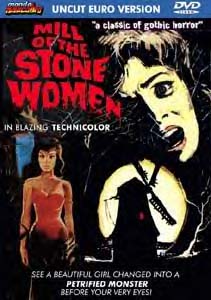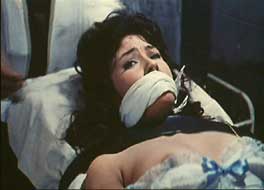 MILL
OF THE STONE WOMEN (1960)
MILL
OF THE STONE WOMEN (1960)Director: Giorgio Ferroni
Mondo Macabro
 MILL
OF THE STONE WOMEN (1960)
MILL
OF THE STONE WOMEN (1960)MILL OF THE STONE WOMEN, unquestionably
one of the finest DVD releases thus far this year of any genre film, does not
resemble an Italian movie but rather looks German or Dutch as its origins in
"Flemish Tales" belies. This glorious, understated work of art in
fact was an Italian-French co-production that arrived in theaters stateside
in 1963 thanks to Parade Pictures. Obvious
influences abound in this film: EYES WITHOUT A FACE, I VAMPIRI, HOUSE OF WAX
and ATOM AGE VAMPIRE, each one involving the restoration of beauty or extending
the life to the already dead. In Italy this classic was known as IL MULINO DELLE
DONNE DI PIETRA and in France, LE MOULIN DES SUPPLICES.
The story unfolds in the windmill-laden countryside and seascapes of Veeze near Rotterdam. Young artist Hans (Pierre Brise) has come to meet Professor Gregorius Wahl, a sculptor and artist himself. Hans is enthralled with the elder's tableaux of horrors that revolve in a windmill (much like a Swiss coo-coo clock) that serves as Wahl's home. The figures are life size and include Joan of Arc tied to the stake and other historical yet macabre figures. He encounters the tragic Elfy, the mortally ill daughter of Dr. Wahl living in denial of her affliction and longing for a normal life. The plot follows the familiar line of a confused hero who with the aid of friends solves the mystery of the Mill of the stone women and watches as it goes up in flames in the Italian tradition of Freda's TERROR OF DR. HICHCOCK.
 The
central character in this film, much like the dual personae in BLACK SUNDAY,
is a woman who becomes a monster as well as a victim of her own desires. Scilla
Gabel is a brunette beauty and like Barbara Steele personifies the Dark Lady
in a most poetic fashion. Her performance here is nuanced and hypnotic which,
along with the Bava-like color scheme, makes this film a jewel in the crown
of Italian film d'orrore.
The
central character in this film, much like the dual personae in BLACK SUNDAY,
is a woman who becomes a monster as well as a victim of her own desires. Scilla
Gabel is a brunette beauty and like Barbara Steele personifies the Dark Lady
in a most poetic fashion. Her performance here is nuanced and hypnotic which,
along with the Bava-like color scheme, makes this film a jewel in the crown
of Italian film d'orrore.
Perugia-born Giorgio Ferroni directed
this stylish masterpiece and most of his output during this period consisted
of pepla such as THE TROJAN HORSE (1962) with Steve Reeves, HERCULES VS. THE
MOLOCH (1963) with Alan Steel, and the colorful and fascinating epic, LION OF
THEBES (1964) with Mark Forest. He later went on to direct BATTLE OF AL-ALAMEIN
in 1968 and a first-rate, feature-length rendition of the "Wurdalak"
tale made in Spain in 1972, NIGHT OF THE DEVILS. Not only did Ferroni direct
MILL OF THE STONE WOMEN; he co-wrote it with the team of Ugo Liberatore, Remigio
del Grosso and Giorgio Stegani who also assisted him in writing many of his
efforts. It is a comment on his respect for this film that he put his real name
on the credits as the director. 
The original score, composed by Carlo Innocenzi, is highly effective with its high strains of piano lending an urgency and macabre counterpoint to the nefarious goings-on. His music keeps the viewer mesmerized and is most memorable. Innocenzi's output, heaviest during the 50s and 60s, consists chiefly of orchestrations for innumerable pepla and adventure movies.
Lensing by Pier Ludovico Pavoni
is sumptuous with windmills and waterways reminiscent of Rembrandt; the cinematographer
distinguished himself mainly with epic films also. His other genre credit was
a science-fiction film from 1961 entitled PLANETS AGAINST US by Romano Ferrara.
The print is glorious and looks as if it had been processed yesterday though
there is a  bit
of variance in color between scenes (as this may have been the marriage of two
prints). The Technicolor is used to ethereal effect and is enhanced by its original
aspect ratio (1:66.1) presentation with anamorphic enhancement. (EDITOR'S NOTE:
A layer change at 1:31:08 (Chapter 17) freezes up the picture in some DVD players--but
it's too early to detect how widespread or serious this problem is).
bit
of variance in color between scenes (as this may have been the marriage of two
prints). The Technicolor is used to ethereal effect and is enhanced by its original
aspect ratio (1:66.1) presentation with anamorphic enhancement. (EDITOR'S NOTE:
A layer change at 1:31:08 (Chapter 17) freezes up the picture in some DVD players--but
it's too early to detect how widespread or serious this problem is).
This release of MILL OF THE STONE WOMEN has an abundance of supplements. Although most welcomed, the deleted and alternate scenes add no further information or plot relevance but are interesting to view. Three different audio tracks include the British, American English and French versions, as well as optional English subtitles. The theatrical trailer is included with a more than adequate collection of images comprising a stills & poster gallery. Extensive production notes and Bios of major players are presented with excellent work courtesy of Mondo Macabro's Pete Toombs. There are even six nude shots of Scilla Gabel to appreciate!
This Mondo Macabro release is a phenomenal sleeper and a lyrical mood piece. It seems that many video retail stores are only obtaining small numbers of copies not realizing what this film is: a treasure and must-have for every aficionado of 1960s Eurohorror. (Christopher Dietrich)